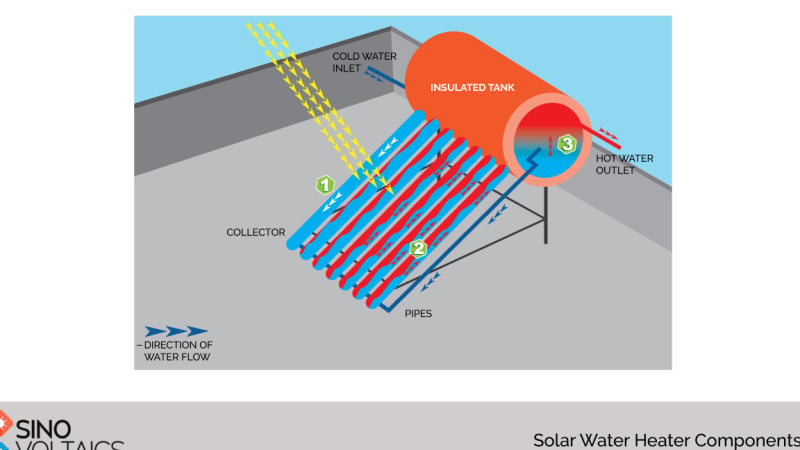Solar Water Heating
The basics of Solar water heating
Introduction to solar water heaters
Solar water heating is used to harness the sunlight and convert it into renewable energy to heat the water. This action is achieved by using solar thermal collectors. Normally solar heating device is installed at the terrace where sunlight is available. The water that is heated is stored in an insulated storage tank for domestic, commercial, and industrial needs. A typical solar water heating system is known to save up to 1500 units of electricity every year, for every 100 liters per day of solar water heating capacity.
Components
Figure 1 below shows the components of a solar water heater. The three main components of solar water heating can be seen in the figure numbered 1,2 and 3 are listed below:
- Solar Collector
- Cold-water tank (contains insulated hot water pipelines and accessories)
- Insulated storage tank
 Water Heater Components - Insulated Storage Tank
Water Heater Components - Insulated Storage Tank
Working Principle
- As sunlight hits the solar collector, the water gets heated up in the glass tubes or metal tubes.
- The hot water rises in various tubes and reaches the top of the insulated hot water storage tank.
- The cold water descends in the tank to the tubes and gets heated.
- The above two processes continue as a cycle.
- The hot water, which is dense, moves upwards into the tank. The insulated tank ensures that the hot water doesn’t lose its heat and maintains it for a long time.
Types of Solar Water Heating Systems
Passive: Passive heaters use heat pipes to circulate water or fluid through the system. There are two types of passive systems:
- Thermo siphon: A thermosyphon system works on the principle of warm water rising and cold water sinking. In Thermosiphon the water tank and the solar collector are separated. Coldwater travels in the solar collector tubes and hot water moves to the storage tank through convection. The water from the storage tank can then be supplied to the house.
- Batch: In this method, Water tanks are placed in the solar collectors and no tubes are present in this system.
Active: In the Active method, pumps are used to circulate water or heat fluid in the system. There are three types of active solar water heaters:
- Direct: Here pumps are used to transfer water in solar collectors to storage tanks.
- Indirect: A fluid like antifreeze is used instead of a liquid in the solar collectors.
- Drainback: Distilled water is used for storage in this method.
What do the Solar Collectors do?
The main function of solar collectors is to absorb solar energy and convert it into heat energy. There are two different types of solar collectors: - Flat-plate collectors - Evacuated-tube collectors
Advantages and disadvantages of Solar Water Heater
The advantages and disadvantages are listed below.
Advantages
- Less space: Solar thermal panels require less space than solar photovoltaic panels. Fewer are required to heat water than in a PV array that is used to provide sufficient power for a home.
- High efficiency: Since 80 percent of the sun’s radiation is turned into heat energy for heating water, they are efficient compared to PV panels.
- Cost savings: They are cheaper for larger domestic installations.
- Low maintenance: They need minimal maintenance, and can run for up to 20 years.
- Lower carbon footprint: They are known to have less carbon footprint than their counterpart PV systems.
Disadvantages
- Compared to their PV counterparts solar thermal panels only heat water.
- A lot of roof space is required to install thermal panels.
- They require direct sunlight to function.
- A major drawback is that they do not function on cloudy, rainy, or foggy days.
- Even though they require less maintenance, periodic maintenance is needed for the pumps and antifreeze.
- As part of Installation, a new hot water cylinder is always required.

raju
on 10 Dec 2021kobarichettu
on 10 Dec 2021Ehrin
on 25 Feb 2022